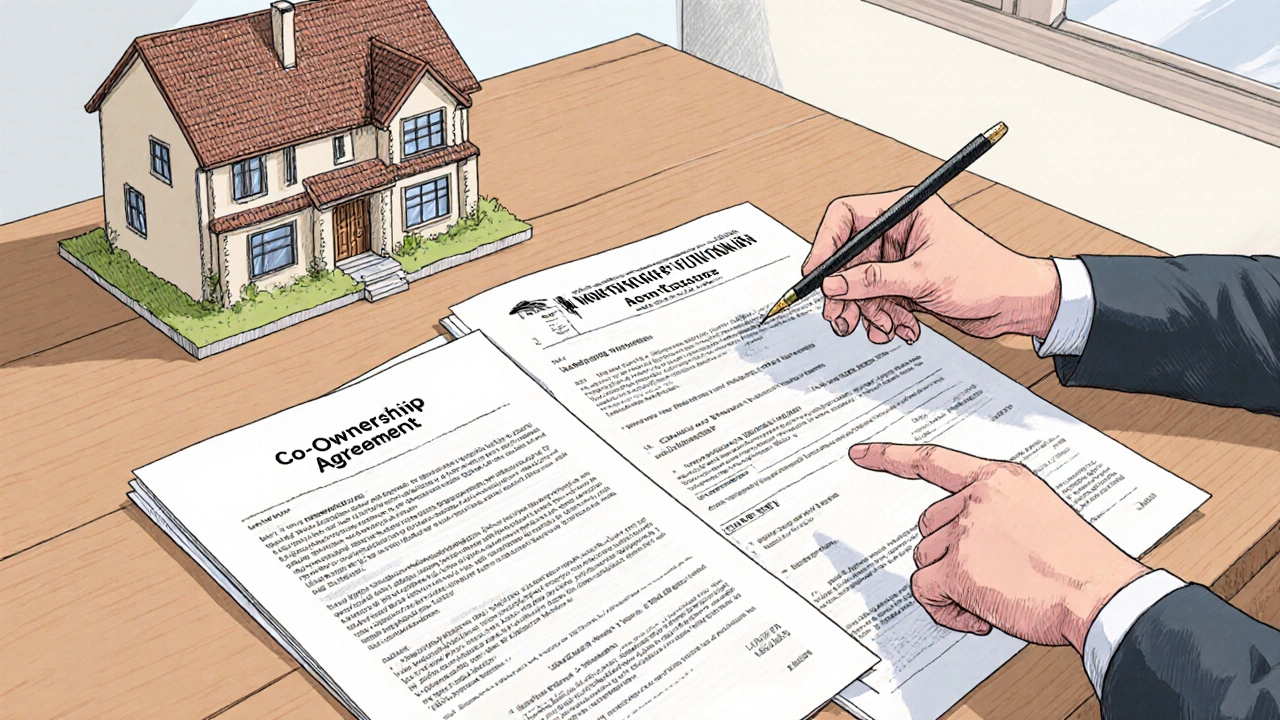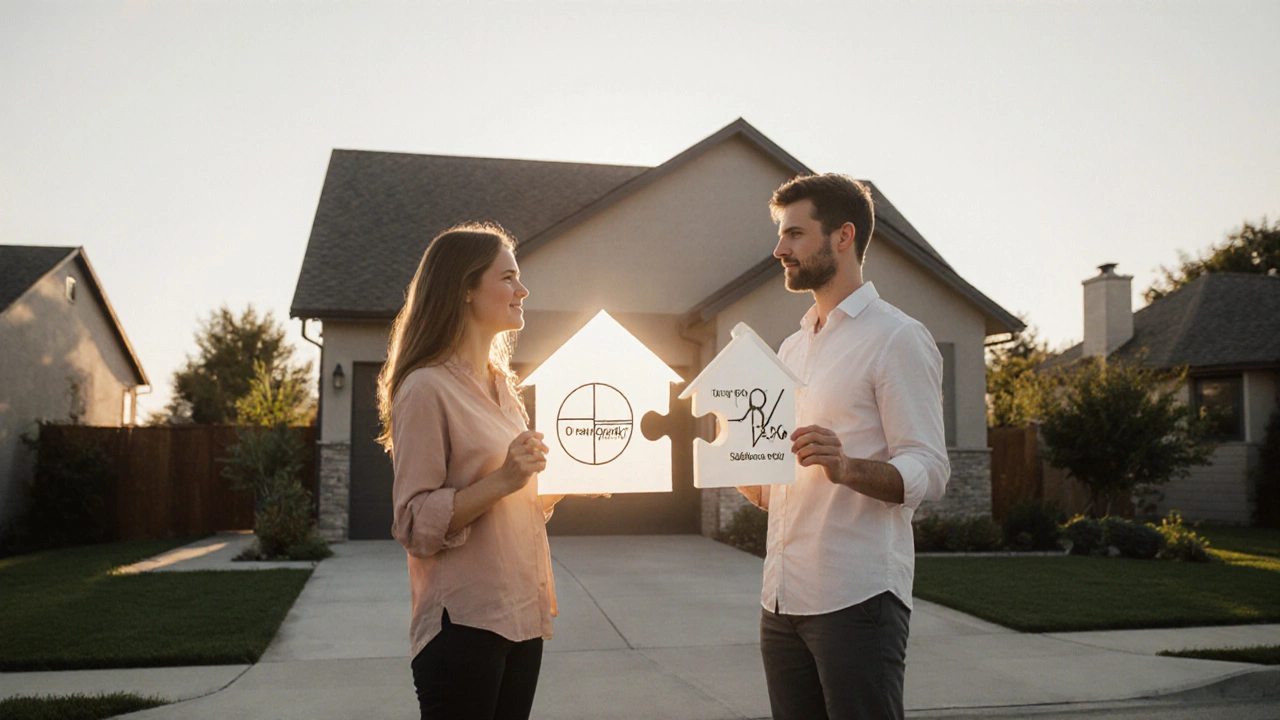Home Share Calculator
This calculator helps you understand the financial aspects of home sharing. Enter your details to see how much you'd need for a down payment, your monthly costs, and how equity grows over time.
Input Details
What You'll Pay
Pro Tip: For a 30% share, you only need a 10-30% deposit on your portion of the property. For example, if the property is valued at $500,000 and you own 30%, your share is $150,000. With a 20% deposit, you'd need $30,000.
Cost Comparison
| Cost Category | Home Share | Traditional Buying | Renting |
|---|---|---|---|
| Initial Deposit | $0 | $0 | $0 |
| Monthly Cost | $0 | $0 | $0 |
| Equity Growth | $0 | $0 | $0 |
Note: Home share monthly costs include your mortgage portion plus proportional share of rates, insurance, and maintenance. Traditional buying covers all costs directly, while renting typically includes utilities and maintenance.
Key Takeaways
- Home shares let two or more parties own a single property while each pays only a portion of the cost.
- Ownership is split into equity percentages, and each owner usually takes on a separate mortgage on their share.
- Legal agreements - co‑ownership contracts, lease or licence terms - protect everybody’s rights.
- Financially, you build equity only on the portion you own, while sharing bills and upkeep.
- Home shares can be a stepping stone for first‑time buyers, downsizers, or investors looking to spread risk.
Ever wondered why some people can afford a house in a pricey market while others can’t? The answer often lies in home shares. Instead of shouldering a 100% mortgage, you lock in a slice of the property, pay your share of the mortgage, and share the rest of the costs with a partner or a housing organisation. Below we break down the mechanics, the money flow, the paperwork, and the pros and cons so you can decide if a home share fits your situation.
What Is a Home Share?
Home Share is a form of shared ownership where two or more parties jointly purchase a property and each holds a defined equity percentage. It differs from a traditional rental because each participant has legal ownership of a portion of the title, not just a tenancy.
How the Ownership Structure Is Built
The backbone of a home share is a Co‑ownership agreement. This contract spells out who owns what, how much each party contributes to the mortgage, and the rules for selling or transferring shares. Typically, the equity split mirrors the cash each buyer puts down - for example, 60%/40% or 70%/30%.
Each owner usually secures an individual Mortgage a loan from a bank or lender that covers the buyer’s share of the purchase price. Banks treat each share as a separate loan, so the credit profile of each co‑owner matters. If one party defaults, the lender can enforce the mortgage on that specific share without automatically dragging the other owner into trouble - though the overall property could still be at risk.
Equity and Financial Flow
Equity is the portion of the home you truly own. As you make mortgage payments, your equity grows, while the other party’s equity grows in parallel with their payments. When the property is sold, each party receives a cash amount proportional to their equity percentage at that moment.
In addition to mortgage installments, co‑owners split ongoing costs - council rates, insurance, utilities, and maintenance. Some home‑share schemes use a single Lease Agreement a legal contract that outlines rent‑like payments for the portion of the property you don’t own to cover the share owned by a housing association or a third‑party investor. This hybrid model mirrors the “shared ownership” scheme popular in the UK, where you buy 75% of a home and pay rent on the remaining 25%.

Legal Framework: What Documents Are Involved?
The first line of defence is the co‑ownership agreement mentioned earlier. It typically includes:
- Exact equity percentages.
- Mortgage responsibilities for each party.
- Procedures for selling, transferring, or buying out a share.
- Dispute‑resolution mechanisms.
Next comes a Lease or licence document that governs the relationship between the owner of the un‑purchased share (often a housing association) and the co‑owner who lives in the property. This document specifies rent‑like payments, service charges, and any usage restrictions.
Finally, a Property Valuation report is required at purchase and at each major refinancing stage. Valuation determines the market value of the entire home, which in turn sets the price of each share.
Roles and Ongoing Management
Who takes care of the day‑to‑day? That’s where Property Management a service that handles maintenance, repairs, and common‑area expenses on behalf of co‑owners can step in, especially when a housing association holds a share. If you and your co‑owner are DIY‑savvy, you might handle those tasks yourselves, but it’s wise to spell out responsibilities in writing.
Many home‑share arrangements are facilitated by a Housing Association a nonprofit or public body that provides affordable housing and may hold a share of the property. The association often offers support services, guarantees mortgage eligibility for lower‑income buyers, and ensures the property remains affordable over time.
In some countries, a Government Scheme policy initiatives such as Help to Buy, Shared Ownership, or equity‑share programmes that subsidise the purchase of a share can make home shares even more accessible. These schemes may cap the resale price or require the buyer to live in the home for a minimum period.
Pros and Cons of Home Shares
Advantages
- Lower entry‑cost: You only need a deposit for your share, not the full price.
- Shared risk: If property values fall, each party bears only their proportionate loss.
- Path to full ownership: Many agreements let you buy additional shares later (staircasing).
- Access to better locations: You can afford a home in a more desirable area than you could buy outright.
Drawbacks
- Complex paperwork: Multiple agreements mean more legal fees and coordination.
- Limited control: Major decisions often require consent from all owners.
- Resale restrictions: Some schemes impose caps on resale price or require first offer to the existing co‑owner.
- Financing hurdles: Lenders may impose stricter criteria for split mortgages.
Home Share vs. Traditional Buying vs. Renting
| Aspect | Home Share | Traditional Buying | Renting |
|---|---|---|---|
| Initial Deposit | 10‑30% of purchase price (only your share) | 15‑20% of full price | Security deposit (usually 1‑2 months rent) |
| Monthly Cost | Mortgage on your share + proportional rates/maintenance | Full mortgage + all expenses | Rent (often includes utilities) |
| Equity Build‑Up | Only on your percentage | 100% of property value | None |
| Control Over Property | Shared - major changes need co‑owner consent | Full ownership rights | Limited - landlord decides |
| Flexibility to Move | Can sell your share (subject to restrictions) | Full sale process | Lease ends, move at term expiry |

Typical Scenarios Where Home Shares Shine
First‑time buyer with a modest deposit: Jane saved NZ$30,000 but the median house price in Auckland is NZ$950,000. By buying a 30% share, she only needs NZ$285,000 plus her deposit, making home ownership possible sooner.
Downsizer looking for lower maintenance: Mike and Sue own a large family home but want a smaller space. They purchase a 50% share in a two‑bed flat, share the upkeep costs with a housing association, and retain the option to upsize later.
Investor spreading risk: An investor buys a 20% stake in several properties rather than a single 100% purchase, diversifying exposure and balancing cash flow.
Step‑by‑Step: How to Get Started with a Home Share
- Assess your finances - calculate how much you can afford for a deposit and monthly mortgage on a share.
- Research schemes - look for local housing associations, government equity‑share programmes, or private co‑ownership platforms.
- Find a suitable property - ensure the seller is willing to sell a partial share or that the scheme provides a ready‑made property.
- Engage a solicitor experienced in co‑ownership - they will draft the co‑ownership agreement, lease (if applicable), and coordinate the mortgage.
- Secure financing - approach lenders that offer split‑mortgage products; you may need to provide proof of income for each owner.
- Complete the valuation - a professional Property Valuation confirms the market value of the whole home.
- Sign the legal documents - co‑ownership agreement, mortgage contracts, lease/license, and any scheme‑specific forms.
- Move in and start sharing costs - set up a joint account for rates, insurance, and maintenance, or let the property manager handle it.
Common Pitfalls and Pro Tips
- Don’t ignore future resale terms. Some schemes require you to sell your share back to the housing association at a capped price.
- Clarify exit clauses. Make sure the agreement defines how you can exit - whether you can sell to a third party or must offer it to the co‑owner first.
- Check the lender’s policy on split mortgages. Not all banks accept a share‑mortgage, so shop around early.
- Plan for the unexpected. If one owner can’t meet payments, the remaining parties may have to cover the shortfall.
- Use a professional property manager. Even a small share can involve complex maintenance schedules; a manager helps keep everything on track.
Next Steps and Resources
If you’re ready to explore a home share, start by contacting a local housing association or a mortgage broker who specialises in shared‑ownership products. Ask for a sample co‑ownership agreement to review the terms before committing.
For deeper insight, consider reading up on the UK’s Shared Ownership scheme, the US’s “Equity Share” programmes, and New Zealand’s recent pilot projects that pair first‑time buyers with institutional investors.
Frequently Asked Questions
Can I buy a home share if I have a low credit score?
A low credit score can make it harder to secure a split mortgage, but many housing associations offer guarantor schemes or government‑backed loans that lower the credit threshold. It’s worth talking to a specialist broker who understands these alternatives.
What happens if one co‑owner wants to sell their share?
The co‑ownership agreement usually includes a right of first refusal for the remaining owners. If they decline, the selling party can list the share on the open market, but many schemes impose price caps to keep the property affordable.
Do I still pay council rates and insurance?
Yes. Council rates, building insurance, and utility bills are split proportionally to each owner’s equity share, unless the agreement assigns all costs to a property manager.
Is staircasing (buying a larger share) possible?
Most home‑share schemes allow you to purchase additional percentages over time, known as staircasing. Each purchase triggers a new valuation and mortgage adjustment.
How does a home share affect my taxes?
You’re taxed on any rental income you receive from the co‑owner’s share (if applicable) and can claim mortgage interest deductions proportionate to your ownership. Consult a tax advisor for country‑specific rules.
